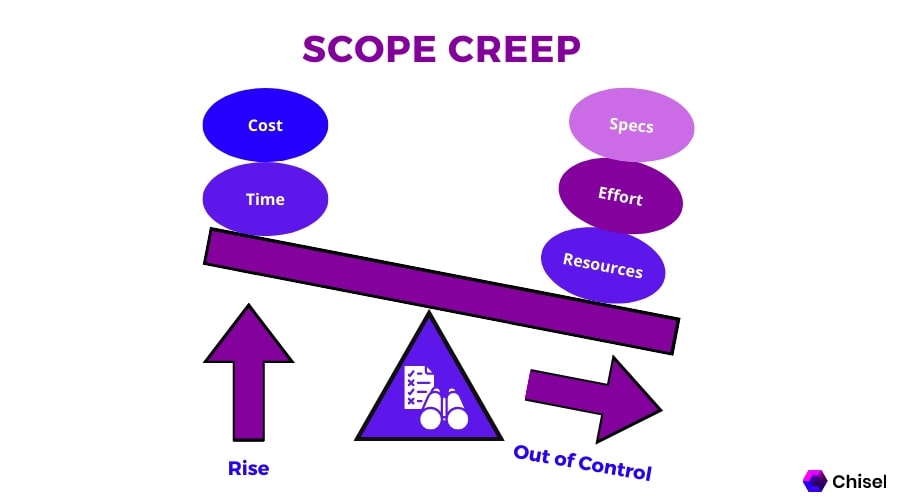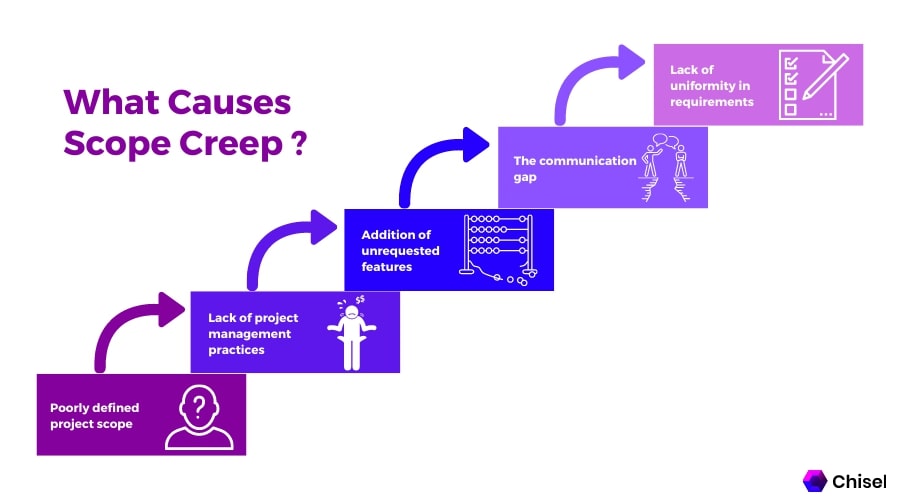
What Is a Scope Creep?
Scope Creep Definition
Scope creep, or requirement creep, are the changes, hurdles, and uncontrolled growth that a project scope witnesses once the project begins. Scope creep usually happens because the project scope is not clearly defined, controlled, and documented. That way, the project will get delayed, and the end look of the project will significantly vary.
Scope creep refers to the unconscious tendency to extend the project goals or requirements until they become undefined. This tendency to delay is often due to a lack of clarity, definition, and lack of control.
One of the reasons why scope creep occurs is the expectations of stakeholders and customers who pose requests regarding a few updates or new features.
It is likely to be disoriented from the primary goal and keep the team’s focus steady.
Scope creep occurs when you complete your project over budget.

However, it is important not to view scope creep in an entirely negative light because it is a natural and crucial process as a part of product development.
Pro tip: To craft some amazing products, use product management software like Chisel.
Still, the problem is when the team gets distracted by the wrong things.
You can incorporate the customer’s needs once the initial requirements of the product align well.
Nevertheless, the product vision must align with all the changes. Otherwise, there is a risk of wasting resources by focusing energy in the wrong places.
Scope Creep in project management
Let’s imagine a scenario wherein, in a bakery, there’s an order for a birthday cake. The owner gets the ingredients and then receives a call to make some changes to the cake.
The cake is not ready yet, so the owner agrees to the changes.
Now the customer keeps on calling and demanding the cake to be in some different way they imagine it to be. However, the delivery time is still the same- one day.
In the above case, everything went haywire because the chef did not clearly define the project’s scope initially and made changes to the timeline, budget, and other things.
That is what we refer to as scope creep, and the project managers have to deal with it all the time when managing projects.
Scope creeping is a subtle deviation from the project’s original scope by adding new features.
According to the PMBOK guide, scope in project management refers to “the extent of what a project will produce and the work needed to produce it.”
The percentage of scope creeping has only been increasing for years now. It was 52% in 2018, and seven years before that, it was 43%.
Scope creep is very commonly in project management.
Teams couldn’t deliver the luggage handling system on time at Denver airport.
The main reason for the scope creep here was the non-consultation of the critical stakeholders on time. And their feedback was necessary to incorporate into the final product.
What Are the Causes of Scope Creep?
One of the causes of scope creep is the additional features and functions that have not been prioritized in the project roadmap keep getting added.
Most of the time, scope creep is due to external factors.
However, internal factors such as miscommunication, lack of understanding of the product vision and goals, or lack of cooperation within the team can play a role.
Some of the causes of scope creep in project management are:
- Lack of communication between project managers and clients
- No clear definition of project scope
- Features request while the project is ongoing
- No uniformity in clients’ requirements

What Are the Challenges of Scope Creep?
Scope creep very likely to go unnoticed until it has reached the last stage and exhausted all the budget.
The cost of the project is often the first sign of scope creep. If you make the additional changes and updates, the financial resources can deplete.
The extra development can also increase other development costs such as design, production, etc., affecting overall profits.
What Are Some Examples of Scope Creep?
One of the high-profile examples of scope creep comes from the construction industry. Here projects go over budget and over time.
In Barcelona, the construction of the Sagrada Familia has been ongoing for over 100 years now.
Another example of scope creep is the delay in opening the library.
Architects in Kitchener, Canada, were building the main library.
However, due to substantial last-minute changes, the library’s opening was delayed by 54 weeks.
The library sued the architects and the city for the delay.
How To Manage Scope Creep?
If you want to manage scope creep, it is necessary to prioritize the product roadmap.
Pro tip: Use the product roadmap software to craft a product roadmap instantly.
Doing so will help the documented changes and display the effect on the timelines and the resources.
A good product roadmap can also help to keep the scope creep in check in the following ways:
- Keep track of the product’s status.
- Keep reminding yourself of the original core objective and the project’s scope.
- You must make constant comparisons between the current progress and the core objective.
- Change requests from clients or stakeholders need to be examined and challenged whether they are worth incorporating.
- When you decide on the change to be incorporated, you must record details of the causes of incorporation and how it will affect the development process.
- You must document all the changes and break them into smaller achievable tasks.
How To Avoid Scope Creep?
You cannot wholly avoid scope creep because doing so can create a very rigid development schedule without much room for flexibility.
However, some ways to keep scope creep in check are documenting the additional changes made in the product roadmap, detailing the necessary change into smaller achievable tasks, and ensuring that the change and its cause are well-examined before executing it.
Finally, constantly keep a tab on whether the work progress is parallel to the core objectives.
How To Avoid Scope Creep in Project Management?
Following are some of the ways you can prevent scope creep in project management:
Define requirements clearly
Have a meeting with stakeholders and decide the requirements. Conclude and create a project plan accordingly.
Control process for change
You must have a control process for change that everyone can use. If you need to address some change at the project time, you must have a team member who will handle all of this.
Schedule the tasks
In your requirements document, schedule all the tasks that need to be in the project.
Double-check
Discuss the final requirements and schedule document with your stakeholders. Doing so will help clear out any miscommunication.
Cross-check with the project team
You must cross-check with your project team members the requirements and the schedule. See to it that the schedule is realistic.
Some ways to manage scope creep in case your project already has it. Then you must take the following steps to bring it back on track.
Identify the scope creep
The first step to managing scope creep is to identify it. It’d become easier to manage the early signs of scope creep than the later ones.
Keep it transparent
You must inform the respective stakeholders and project team members about the scope creep and work toward getting the project on track.
Setting limitations
You may have to discard changes and make decisions for your timelines and budget.
You may also be interested in:
FAQs
Mostly, you will see the scope creep in a negative light. However, it is only a natural process and is often quite essential for the company’s growth.
Nevertheless, it is essential to keep track of scope creep to prevent wastage of resources.
Continuous changes in project or scope creep can disrupt your project schedule, waste the company’s resources, and weaken team communication and performance. All of this can lead to significantly less chance of your project’s success.
Don’t let the scope creeper cripple your project. Take the guidance of the following five steps of effective project governance:
- Firstly document the right project requirements
- Have a change management plan ready
- With a work breakdown structure, create a clear project schedule
- Verifying the scope of the project with respective stakeholders
- Engage well with the project team members as well.
